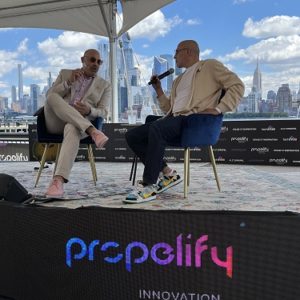At VANJ, VC Joe Allegra Advises Growth Companies Seeking Money
On the same day that VC Joe Allegra presented at a recent VANJ luncheon, his firm, Edison Ventures (Lawrenceville, N.J.), announced it had closed a $249 million fund, its seventh. The fund is off to a strong start, investing $55 million in companies already in its portfolio. The only inititial investment made by the Edison VII fund in a N.J. company was follow-on money for PHX, a healthcare IT firm in Bedminster.
Edison Ventures funds financial and healthcare technology, interactive marketing and e-commerce, and Enterprise 2.0. It invests in companies that are well along, with between $5 million and $20 million in annual revenue and at least a 25 percent growth rate at the time of investment. Edison invests between $5 million and $10 million to accelerate a company’s growth by some 30 percent to 60 percent.
Allegra’s talk was to be about “Investor Guidance on Business Plans and Presentations,” which he began after providing extensive guidance on what kinds of companies Edison wants to evaluate.
“We’re looking for growth companies that have some unique intellectual property,” he said. “We invest in a lot of firms whose founders happen to be domain experts,” he added. The founders leave these to pursue the solution to some problem in an industry they know well. The VCs also like recurring revenue companies, like software as a service offerings. “It turns out that valuations are much higher in recurring revenue model companies,” versus the license model. “The companies going public these days are all recurring revenue models,” Allegra noted.
When Edison invests in a company, it is usually at a break-even point because it’s had to be. “Our money will probably take you negative for a while,” he said, while the company makes major investments in sales and marketing, making a transition from the “founder sales model” to the “institutional sales model.
According to Allegra, the one thing founders have to know is, “If you take venture capital, you are on the path to an exit. If you don’t take money from anyone, you can do what you want.” So the company will be sold or, in rare cases, go out for an initial public offering. Edison looks for a buyer before it invests. The firm examines the overall market for potential matches. The best possible outcome is to find a company that will say, “We have a gap in our product line that this company fills.”
Adds Allegra, “If a big company buys you, you have to be a high gross-margin business … a business it can put in the hands of its sales team and get tremendous scale out of.” When looking for a company to fund, Edison asks the question, Can we accelerate growth by 40 percent for five years, and when another company buys it, will it be able to double or triple the company’s size?
Edison looks for businesses with proprietary technology that can’t easily be duplicated by a competitor. Cool tech isn’t enough. A company has to know if its technology will be appreciated by customers. “Generally, people buy technology to solve some problem,” Allegra said. So his big question, he noted, is, Does the solution meet an urgent need, or is it just nice to have? To Allegra, one indication of an urgent need: the company has to cut projects across the board, but yours still gets funded.
It’s also important for companies to be both market and thought leaders in an industry. Go out there and make up terms for what you do, Allegra advised. While you may think it’s only the Gartner of the world that make up catch phrases and industry jargon, companies often do this as well, and founders can then influence their industry in this way, making their companies more attractive to VCs. One reason VCs like market leaders, Allegra said: they have self-sustaining pipelines and don’t have to work as hard to get customers.
On the issue of business plans, Allegra said it isn’t necessary to provide a VC with an entire plan. A two- or three-page executive summary or 15 to 20 slides is all you need. The executive summary is not intended to tell the whole story but simply to whet the VC’s appetite. The first paragraph should tell “What aisle and what shelf”—where your company fits in in the market. Indicate the companies yours is comparable to. The summary should then go to the compelling proposition: what problem you solve better than everyone else.
Tech companies have a hard time remembering that “it’s not about the technology” but the problem, Allegra noted. “I find it’s easier to understand what a company is about” if it clearly identifies the problems it can solve or “if you tell a story about how someone has used your product to solve a problem.” Then indicate how much [money] you are raising and what you will do with it, he suggested.
Talk about your market positioning and identify whether the market is large enough to support several companies, Allegra advised. You must address the competition. The one thing he says drives him crazy: companies claiming they have no competition and are conservative with their numbers. Tell how you differ from your competitors—specifically, how you solve problems—and what that will mean to buyers. Also discuss your sales and distribution. “To me, this is critical,” comments Allegra. “There is a lot of lousy technology out there with great sales and marketing organizations,” and these firms are successful anyway, he implied.


